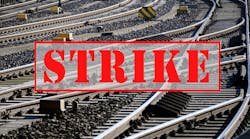COMMENTARY & ANALYSIS
Congress managed to snatch back from the precipice the imminent danger of a nationwide railroad strike that President Biden’s efforts had failed to effectively address last September, but the real source of rail workers desperate concerns—a radical cost-cutting operations model adopted over the past five years—remains active and will continue to bedevil rail customers as well as workers until Congress and the administration are willing to put an end to it.
President Biden seemed sufficiently grateful to Congress after it passed legislation compelling the unions to accept the agreement reached earlier due to the administration’s intervention in the negotiations. The rank-and-file members of four of the 12 rejected that settlement over attendance disciplinary policies and lack of adequate paid sick leave.
“Congress’ decisive action ensures that we will avoid the impending, devastating economic consequences for workers, families and communities across the country,” Biden declared after the legislation already approved by the House had passed the Senate on Dec. 1.
Policymakers, the business community and those following the drama in the news media were relieved that the country would not face costly disruption to the economy that would have taken place in the middle of the Christmas buying season had the strike taken place when it was originally slated to begin on Dec. 9.
The unions were not shy about addressing the underlying issue behind the attendance conflict. “Passing legislation to adopt tentative agreements that exclude paid sick leave for railroad workers will not address rail service issues,” said the Brotherhood of Maintenance of Way Employees, a division of the Teamsters Union, and one of the four unions whose members voted down the agreement. “Rather, it will worsen supply chain issues and further sicken, infuriate and disenfranchise railroad workers as they continue shouldering the burdens of the railroads’ mismanagement.”
The House of Representatives did approve a second bill calling for the agreement to be changed to include seven additional paid sick leave days a year instead of a single day, which was included in the original settlement. However, the Senate failed to approve a similar measure.
The Class 1 railroads and their unions had been negotiating over a new collective bargaining agreement for years. Ian Jefferies, president of the Association of American Railroads, commented, “As we close out this long, challenging process, none of the parties achieved everything they advocated for. The product of these agreements is a compromise by nature, but the result is one of substantial gains for rail employees.”
Not Out of the Woods Yet
While rail customers expressed their gratitude for the resolution imposed by Congress, those companies also recognize that the same rail service failure issues they had been complaining about for years have left deep scars and will continue to persist unless they are addressed by policymakers at the national level.
“This legislation puts one major problem to rest, but we’re certainly not out of the woods yet when it comes to fixing the breakdown of the freight rail network,” acknowledged Chris Jahn, president of the American Chemistry Council (ACC). “To get to the heart of the matter and prevent the next crisis, Congress and the Surface Transportation Board (STB) must address the root causes of rail service problems that continue to put the brakes on U.S. manufacturing.”
Specifically, Jahn called on Congress and the STB to adopt long overdue regulatory reforms that he said will set clear service standards, track how well major railroads are performing for their customers, and provide greater access to competitive rail service through reciprocal switching, where railroads are compelled to allow other railroads’ rolling stock to operate on their lines.
National Association of Chemical Distributors (NACD) president Eric R. Byer echoed those same concerns while hailing the swift congressional action on the threatened strike. “I raised the issue of sick time in an op-ed after hearing directly from NACD members about the challenges they have faced due to declining service in the rail industry brought on by reductions in the workforce,” he noted.
“I continue to believe that freight rail service will continue to deteriorate until some wholesale changes take place in the industry, and NACD will continue to work with both parties in Congress as well as the executive branch and the rail industry to improve performance.,” Byer stressed.
Speaking for his members, National Retail Federation president Matthew Shay observed, “We are grateful for the swift action in Congress this week to implement the tentative agreement, and we look forward to President Biden’s immediate signature to safeguard smooth and stable rail operations.”
He explained,“The freight and commuter rail systems are essential partners to America’s retailers, moving goods throughout the country every day. A nationwide rail strike at this juncture would have had devastating consequences for our economy, and exacerbated inflation for American families.”
Sarah Gilmore, director of government affairs at the Retail Industry Leaders Association (RILA), offered that “American consumers can rest assured they will have an exceptional shopping experience this holiday season with the threat of a rail strike averted.”
National Corn Growers Association president Tom Haag added, “We are extremely relieved that Congress took action to head off a strike that would have had serious consequences for America’s farmers, who are grappling with an increase in input costs and barge rates due to severe drought conditions on the Mississippi River.”
American Trucking Associations president Chris Spear also was clear about the damage that would have occurred had the strike been allowed to take place. “Hospitals, businesses and ordinary Americans depend on freight rail and trucking for daily necessities, and the trucking industry has neither the equipment nor the manpower to replace a single day of lost freight rail service,” he pointed out.




